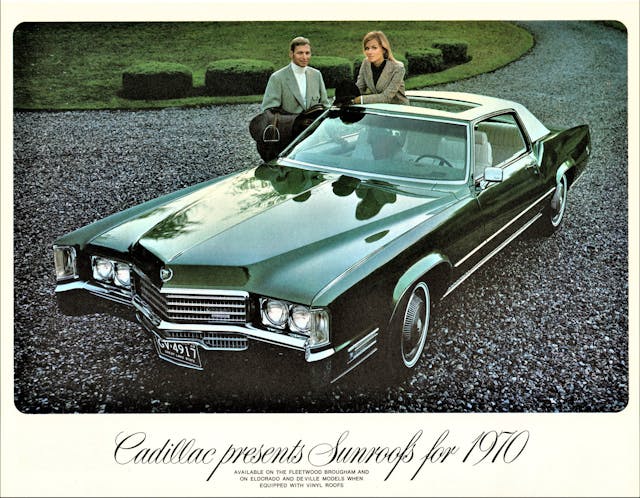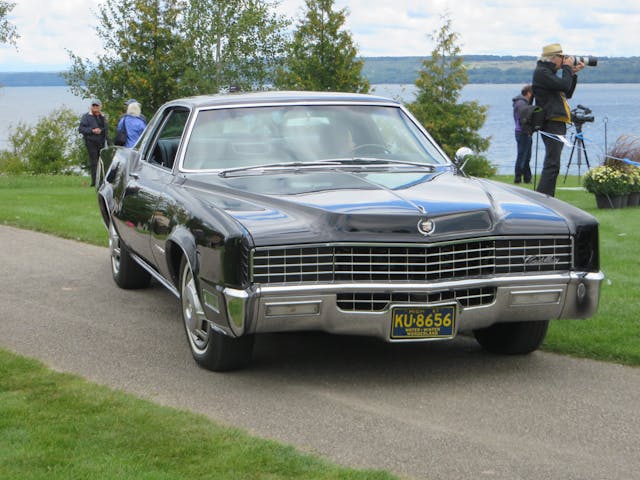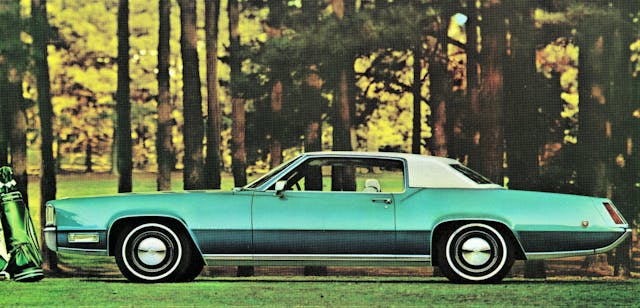1967–70 Cadillac Eldorados offer Rat Pack style for a rat rod budget
Ah, the “personal luxury car.” It’s a market segment that’s all but extinct these days, but in the 1960s these slightly sporty, mostly comfortable two-doors were all the rage.
The 1958 Thunderbird got the ball rolling when Ford grew the T-Bird, added rear seats, softened it up, then saw sales explode. As demand faltered for the ultra-exclusive, ultra-expensive flagship cars seen in the 1950s, manufacturers turned to higher-volume models for the swinging ’60s. The Studebaker Avanti arrived in 1962, but it took GM until 1963 to come out with its own personal luxury car competitor, which arrived with the Buick Riviera. Then came the breakthrough front-wheel drive Oldsmobile Toronado in 1966.
Finally, Cadillac got in on the action in 1967 with the eighth-generation Eldorado. Built on the same platform on the Oldsmobile, Cadillac’s late entry to the personal luxury party was also the company’s first front-drive model. Today, like most classic personal luxury cars, the 1967–70 Eldorado offers a ton (4700 pounds, to be precise) of style and power for the dollar.

Cadillac tossed around the idea of a front-wheel-drive personal luxury car several years earlier, but it never got off the ground. However, Cadillac’s execs couldn’t ignore the success of the E-body Toronado, and in October 1966 a new car was ready. Because it represented such a significant departure from the norm for Cadillac—and because front-wheel-drive carried over to dozens of Cadillac’s subsequent offerings—the Toronado was arguably the company’s most significant car of the decade.
Marketplace
Buy and sell classics with confidence
Like the Toronado, the new Eldorado rode on the E-body platform, which included semi-unibody construction, torsion-bar front suspension, and a Turbo-Hydramatic transmission. The Eldorado also adopted the Oldsmobile’s powertrain layout, with the torque converter separated from the gearbox and linked by chain drive. Aside from the windshield and cowl, however, the Eldorado wore in-house styling and Cadillac used its own engine and brakes. Front discs were optional, as were bucket seats. Another extra in the Eldorado was a self-leveling system that kept the rear of the car even when carrying a heavy load in the trunk.
Available only as a two-door hardtop, the 1967 Eldorado’s tightly creased Bill Mitchell-penned shape was also more angular than the Toronado’s, and the egg-crate grille concealed hidden headlights behind vacuum-operated doors. The car carried a base price of $6277, about $1600 more than a Toronado but still much more affordable than luxury cruisers that wore an Eldorado badge a decade earlier. In Cadillac’s 1967 lineup, the Eldorado slotted below the Fleetwood 75 but above the De Ville.

Period ads touted the Eldorado’s personal luxury credentials, declaring that it “provides the spirit and action of a performance car with the comfort and elegance of a luxury car,” and that “its poised elegance imparts an air of youthful dignity and daring that makes the Eldorado the most desired motor car of its kind.” Reviews were generally positive, and the only serious complaint concerned the handling; reviewers reported with heavy understeer under hard cornering.

Cadillac sold nearly 18,000 Eldorados for 1967, which helped give Cadillac its best-ever sales year. External changes for 1968 were minor, but under the hood sat a new, larger 472-cu-in V-8 rated at 375 hp, which replaced the old 340-hp 429. The hidden headlights disappeared in 1969, and in 1970 a new 500-cu-in engine (the largest V-8 Cadillac ever put into production) arrived with a full 400 hp. A ninth-generation model debuted for 1971 that was both longer and heavier and also available as a convertible.
Values for the eighth-gen Eldos haven’t witnessed much drama. They crept up a bit over the first half of the 2010s, but condition #2 (Excellent) values are actually down 7 percent over the past two years and now roughly match their 2014 levels. The median #2 value currently sits at $22,250—Not exactly chump change, but it’s a lot of car (and a ton of displacement) per dollar.

Unsurprisingly, first-year 1967 models are worth the most, with a #2 value of $25,700. From 1968–70, values dip a few percent each year, but generally you’re looking at the low-$20,000 range for a very good example, somewhere in the low-teens for a decent driver-condition model, or around the 30s for a concours-ready creampuff. Most of the cars we’ve seen selling in the past couple of years brought under $20,000.
The Eldorado’s primary competitor when it was new, the 1969–71 Lincoln Continental Mark III, carries similar values and has followed similar trends. So has the Caddy’s in-house rival, the Oldsmobile Toronado, although the Olds has more of a following and is actually a bit pricier, with a median #2 value of $26,600. The 1967–71 Ford Thunderbird looks downright cheap in comparison at $13,800 for a “Glamour Bird” in #2 condition. Back to Cadillacs, the 1971–78 Eldorado that came after is worth a bit less (#2 values are mostly in the teens), but earlier 1962–66 Eldos (all convertibles) are in a different league, with #2 values ranging from $45,000 to over $70K.
As for who’s into 1967–70 Eldorados, it’s no surprise that baby boomers comprise the biggest fanbase. Nearly half of buyer interest comes from them, even though boomers represent just 39 percent of the market as a whole. Although millennials make up 22 percent of the market, they account for only 12 percent of the buyer interest for these cars. The number of insurance quotes have also dipped over the past three years, so these front-drive Caddies aren’t exactly on a tear. However, with gas as cheap as it is, old luxury boats like this never looked so good. If you’re looking for Rat Pack style on a rat rod budget, a 1967–70 Eldo isn’t a bad choice.
Like this article? Check out Hagerty Insider, our e-magazine devoted to tracking trends in the collector car market.







